
3S is the abbreviation for “Seiwa Scholars Society,” which consists of the past and current Inamori Research Grant recipients. The 3S has evolved since 1997 with the hope that the interactions among the various specialties of the 3S members can lead to the further development of the research of their own. In the series “Visiting 3S Researchers,” we interview researchers in 3S who are very active in a variety of fields. The fourth interview is with Dr. Yuichi Takeuchi (2016 Inamori Research Grant Recipient) from the University of Toyama.
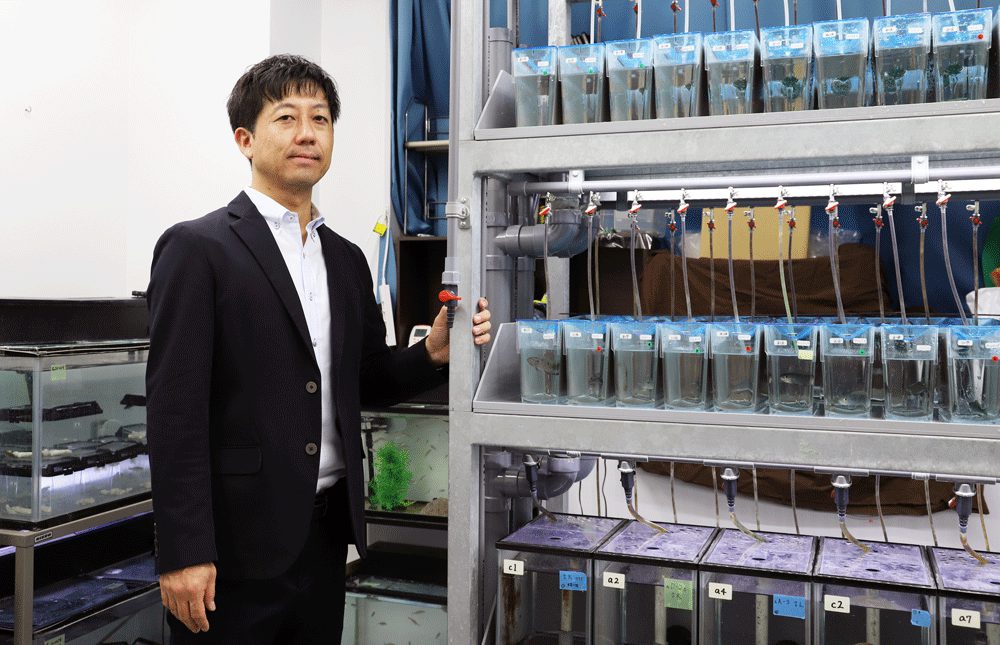
Many animals, not just humans, display laterality, or “right- or left-handedness.” However, its mechanism and how it relates to the difference between the left and right sides of the brain still remains largely unknown. That is why Dr. Yuichi Takeuchi, an assistant professor at the University of Toyama, is carrying out research to have a better understanding of the brain mechanism involved by focusing on a fish species that shows pronounced laterality. Dr. Takeuchi seeks to understand the phenomenon of laterality from interdisciplinary perspectives. We asked Dr. Takeuchi about his research style—finding excitement and taking on challenges in research areas where no one else has been working—as well as the latest developments and future prospects for his research.
── To begin with, what exactly is the phenomenon of laterality, as seen in right- or left-handedness?
Dr. Takeuchi (title omitted below) When using our hands, for example, we see differences in the frequency of their use and also differences in speed, strength, and movement accuracy between each hand. This phenomenon of using one side of the body more often than the other can be seen in even many different animals. This sort of dominant-side use is seen not only with hands and feet, but also with eyes and ears. In the case of the right- and left-handedness of humans, about 90% of people are right-handed—across all countries and cultures. So, the ratio of right/left dominance seems to be determined by biological factors somehow. Then, what decides the ratio? The principle of contralateral control states that the right hand is mainly controlled by the left brain and the left hand by the right brain. This principle suggests some sort of correlation between laterality and the lateral difference in brain functions, however, the specific mechanism involved remains largely unknown.
── So, the mechanism of laterality has not yet been fully understood.
Takeuchi Most research on laterality has been carried out in relation to hand-use in human, but we still don’t know how the dominant hand is decided. It could be due to genetic or environmental factors, such as experience gained during the developmental process. However, both factors seem to be interrelated in a complicated fashion, and the precise mechanism is still not clearly understood. I think that is why this is an interesting topic; we do not fully understand it. I want to unravel one of these mysteries of life hidden in a phenomenon that everyone knows—like the right/left dominance of hand use. There are as many as 100 billion neurons in a human brain, and it is their activities that create the elaborate and powerful movements of our bodies. Currently, however, we do not have any comprehensive and precise way to analyze the activities of our own brains. So, in order to better understand the phenomenon of laterality, we are studying fish because their brains have the same basic setup as humans, but with a relatively simple structure comprising only about one million neurons. Specifically, we are studying scale-eating fish species which show obvious lateralized behaviors when targeting prey.
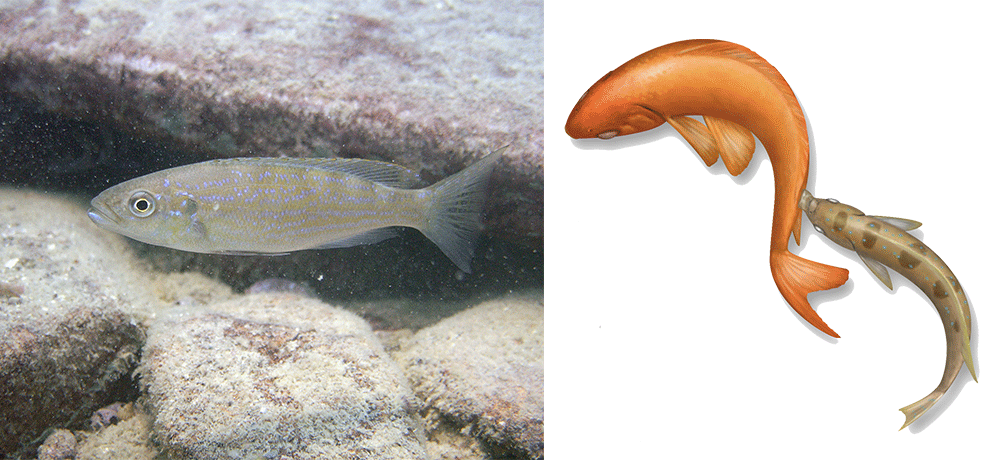
── What are scale-eating fish which display laterality like?
Takeuchi Scale-eating fish are a species of cichlid (family Cichlidae, order Perciformes), and they literally eat the scales of other fish. I am studying a specific kind of scale-eating fish that lives in Lake Tanganyika in East Africa. The “righties” have a right lower jawbone that is larger than the left one and attack from the right side of their prey, while the others, or “lefties,” vice versa. The direction of the attack is determined by the way in which their mouth opens, which in turn is caused by the difference in the size of their left/right lower jawbones. I first learned about this fish during my doctoral program. I stayed at Lake Tanganyika in Zambia in 2004 and 2005 for about six months in total. I spent about five hours underwater, each day, in order to observe and catch fish.

Takeuchi Since I did not have any diving experience before starting this study, I first had to get a diving license in Japan. Then I received further instruction on diving for investigation from a researcher I knew who was studying fishes on Iriomote Island in Okinawa Prefecture. I didn’t really think about whether I was any good at underwater research—I just wanted to go to Africa. I believe that taking on new challenges, when necessary, is important. In my case, I think that the decision to take on the challenge was the key to the development of my subsequent research. If no one is working on a specific area, it means that no one is willing to take on the challenge, or that some people may have tried—but failed. If nobody is exploring that theme, that just makes it worth me studying even more.
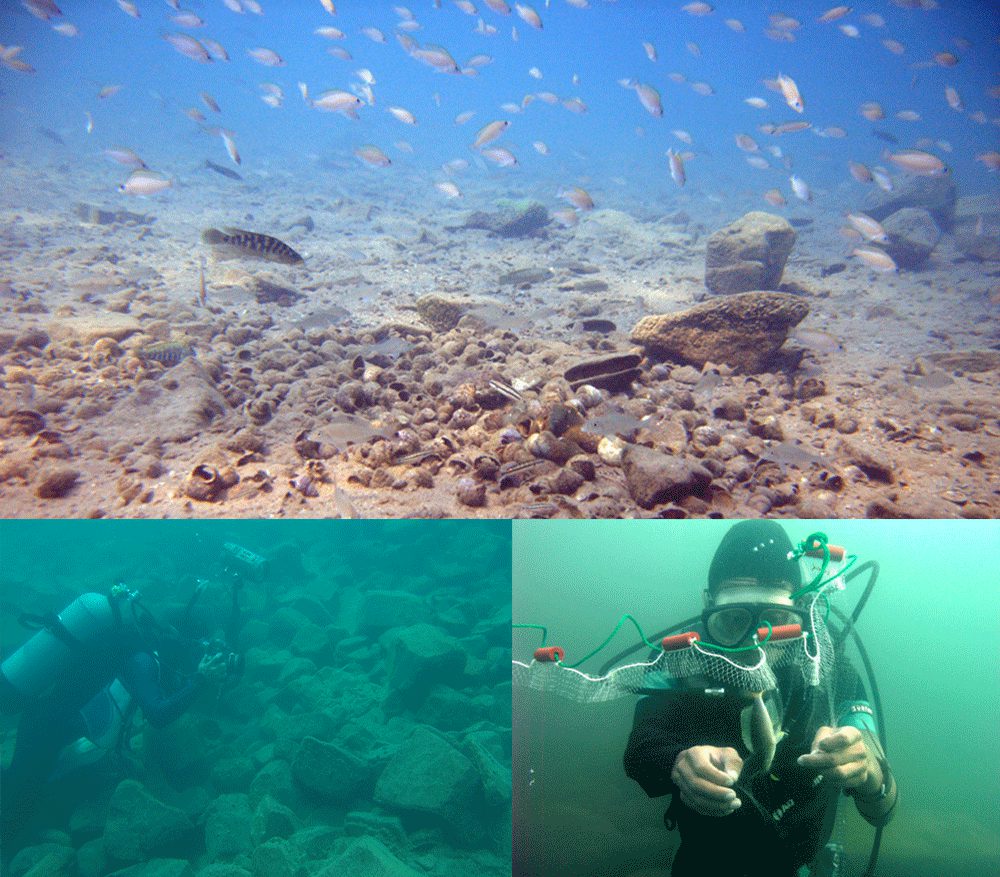
Takeuchi Field research is very important in order to understand how specific species of fish live and how they interact with other fish. In addition to the relationships between individual fish, I also wanted to study the neuronal mechanism that controls their behavior. In order to carry out this research, I needed to bring some fish back to the laboratory for further detailed observation and experimentation. It was also necessary to reproduce the local environment as much as possible to successfully keep these fish in the laboratory. So, my seeing the actual underwater environment in the lake, first-hand, was a valuable experience.
── How did you breed the fish in the laboratory?
Takeuchi Actually, breeding these fish in the laboratory was quite difficult, so we asked an aquarium in Gifu Prefecture to do the breeding for us. The aquarium breeds the fish, and then we keep them in our fish tanks at the lab. Because of this, we no longer have to rely on importing scale-eating fish, and this has allowed us to carry out a wider range of studies. Now we have stable numbers of fish available for research purposes. In addition, we can now track the growth of the fish starting at the fry stage throughout their development. Recently, genomic information for several cichlid species in Africa has also become available that has allowed rapid progress to be made in the genetic analysis of scale-eating fish. We are studying the genes that relate to laterality and have found five genes that show significantly different expressions in the right and left hemispheres. These genes are known to be involved in the formation of the left-right axis at an early stage of embryonic development, which, we believe, is involved in maintaining the left-right difference in the brains of adult fish. Now we are conducting joint research on this universality of left-right differences in the brain, comparing our results with those of other model animals, such as zebrafish and killifish.
── You are conducting joint research with researchers from various fields.
Takeuchi As a medium-term goal, we seek to understand the brain mechanism that governs right/left dominance. This involves difficult questions that have not yet been answered for any animal species, including humans. Therefore, this research theme must be studied from many different perspectives. In addition to the neuroscientific approaches and the genome analysis I mentioned earlier, we are also working on evolutionary analysis. We are carrying out a research project on cichlids in Lake Malawi that is located to the southeast of Lake Tanganyika and has an even higher diversity of cichlids. Added to these, in collaboration with mathematical analysis experts, a simulation analysis of laterality acquisition algorithms is currently underway based on the experimental data concerning fish behavior that we have already obtained.
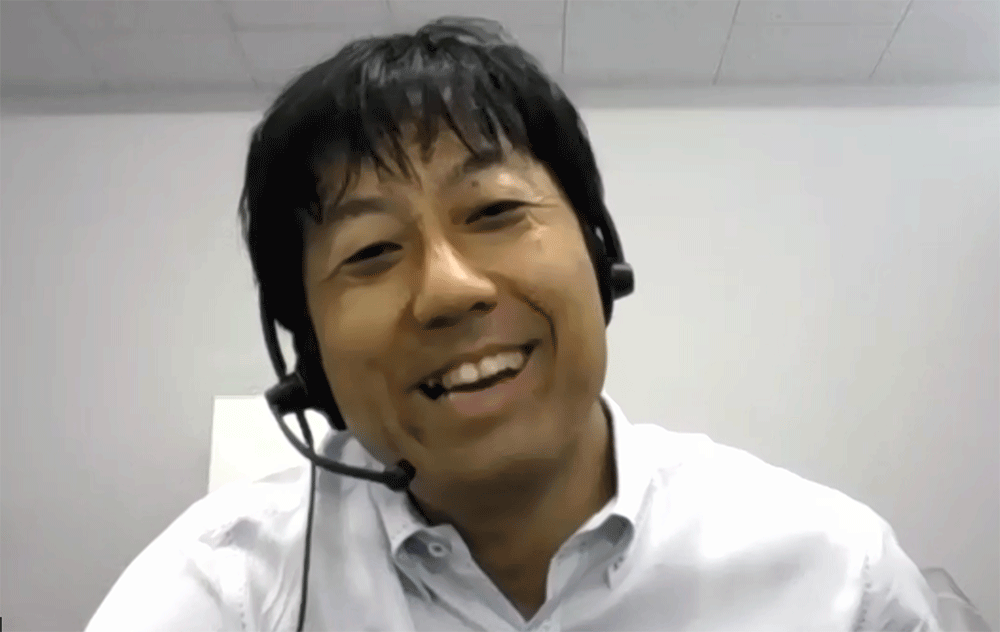
── Do you make any special effort in finding collaborators from different fields?
Takeuchi Regardless of the field, I want to do as much as I can myself, wherever possible. Some researchers may prefer to focus on their own specific fields. A brain scientist may work only on brain studies, or a field researcher may concentrate on field work. But I want to approach the research question from many different directions. That’s why I’m studying various fields and developing my research skills. Even so, I cannot always pursue some of these ideas on my own. Then, I look for someone who seems to be able to turn my idea into reality. What is important in such cases is to approach possible partners for collaboration after developing a solid research scenario. If you can express your enthusiasm for the research topic and outline the possibility of successful outcomes, you should be able to find a research partner.
── Where do you find your research partners?
Takeuchi Academic conferences are valuable opportunities for me. At a conference, for example, a person I know may tell me about other attendees who can do something that I am interested in. I also visit the vendor booths, where new research methods or the latest tools that are likely to become popular are displayed, and I look for anything I can use in my research. Unfortunately, however, most conferences have only been held online recently due to the COVID-19 pandemic, and we have lost these opportunities to meet new people. This is a stumbling block for those of us who wish to carry out interdisciplinary research from different perspectives.
── What is your current state and prospects of your research?
Takeuchi We recorded scale-eating behaviors with a high-speed video camera and then carried out motion analysis. We found that there was a left-right difference in body flexion movement capability during predatory attacks.*1 We were also able to observe the development of laterality in detail throughout different developmental stages, starting with the juvenile stage. This was made possible because we were able to conduct both field works and laboratory tests, thanks to the success of the artificial breeding program for the first time in the world. As a result, we found that naive juvenile fish without scale-eating experience attacked their prey from both sides.*2 As they accumulated experience in predation, however, the frequency of attacks from one particular side, corresponding to the asymmetry of their mouth shape, started to increase. That is, learning through experience enhances the behavioral laterality during attacks.
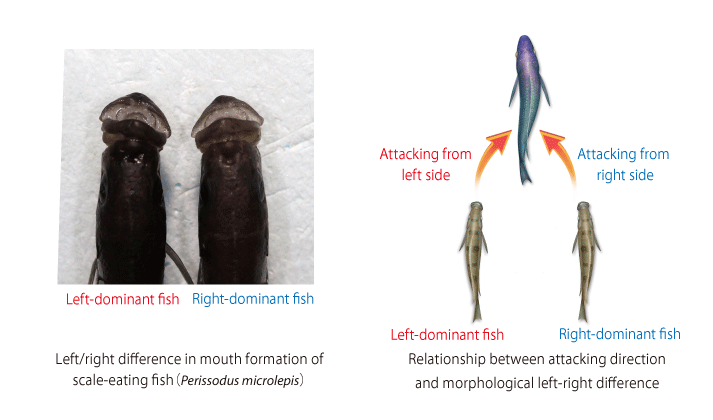
Takeuchi The hindbrain of fish contain Mauthner cells, which are known to drive quick flexion movements of their bodies. Our findings, so far, suggest that these Mauthner cells are also involved in the behavioral laterality of scale-eating fish. In collaboration with Professor Yoichi Oda of Nagoya University, we are currently working on the three-dimensional morphological analysis of neurons in order to determine the activities of Mauthner cells and how these relate to neuroanatomical left-right differences. We are also conducting experiments on a lateralized visual system in scale-eating fish. Although this work is still at the preliminary experiment stage, for scale-eating fish, having a dominant eye seems to play an important role in their predation behavior.
We are planning to develop a comprehensive understanding of the mechanism and roles of laterality by approaching the subject from five major perspectives: neural mechanisms, molecular genetics, developmental processes, ecological functions, and evolution. As the basic structure of the brain is common to all vertebrates, understanding the mechanism of laterality in scale-eating fish should also help understand laterality in other species. We hope that our study will lead to a better understanding of the constructive principles and the origin of the control mechanism responsible for right- or left-handedness in humans.
── What led you to the career of a researcher?
Takeuchi Actually, I already wanted to be a researcher of living things when I was still in kindergarten. I never even thought about other occupations as an option. It wasn’t just that I adored specific animals. Rather, I was interested in ways animals live and vital phenomena affecting their lives. Even if I hadn’t had the chance to study scale-eating fish, I would definitely have been studying the vital phenomena of some other species. When I was an undergraduate student, I studied the color vision of swallowtail butterflies. During my master’s program, I studied the density effects of tiger beetle larvae. Then, I asked my advisor at Kyoto University, Professor Michio Hori, to let me change my research topic to fishes in Africa.
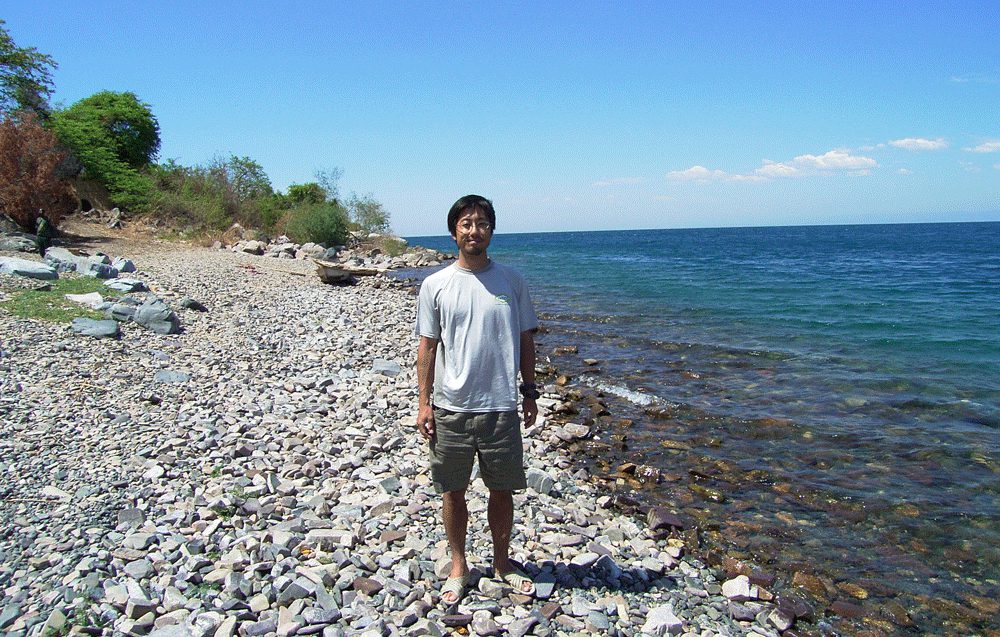
── Could you tell us some stories about your involvement with living organisms in your childhood?
Takeuchi I’ve just loved watching living things ever since I was a little kid. One of my most memorable experiences is the study on antlions that I carried out as a homework assignment during the summer vacation when I was in the third grade in elementary school. I didn’t just watch them building nests. I prepared three plastic cases and filled each one with different grain sizes of sand and studied the resulting differences in antlion behavior. I also remember observing the behaviors of many different organisms, such as stag beetles, cicadas, spiders, and earthworms. My mother was a great supporter. She encouraged me to do whatever I wanted. She helped with observations and sometimes, when I got stuck, she gave me some little hint. So, I guess I was absorbed in the enjoyment of observing living organisms even when I was a child. Even now, I place the observation of phenomena at the center of my research activities, and I value the importance of careful observation. In this way, we can pursue studies of internal mechanisms from a micro perspective or work on understanding inter-individual interactions from a macro perspective. Both are equally important and I enjoy from a variety of perspectives.
── Thank you very much.
| By My Side |
Network The ideas that Dr. Takeuchi got from meeting and talking with other people have paved the way for his career as a researcher. Once, at the poster session of the Japan Neuroscience Society meeting, for example, a person who was standing still and staring his poster said to him, “This is very interesting.” Now, Dr. Takeuchi works with that person, Professor Hiroyuki Ichijo of the University of Toyama (right). “It’s not too much to say that I am where I am now because of the support from people I have met, including my research partners.”  |
|---|---|
| This Book | “Right Hand, Left Hand: The Origins of Asymmetry in Brains, Bodies, Atoms and Cultures” by Chris McManus The theme of laterality has been studied much more by researchers in the humanities than in the sciences. Still, many of the essential questions raised eventually end up overlapping. This book, which examines various viewpoints concerning right- and left-handedness, has been a source of inspiration for Dr. Takeuchi. “When I see a question that I think I can answer with my research on fish, I will take on that challenge.”  |
Yuichi Takeuchi
Assistant Professor, Department of Anatomy, Faculty of Medicine, the University of Toyama. Born in Ehime in 1978. Dr. Takeuchi graduated from the School of Science, Yokohama City University, in 2002 and completed his Ph.D. in Science at the Graduate School of Science, Kyoto University in 2008. After studying as a Global COE Researcher at Kyoto University’s Faculty of Science and then as a Research Fellowship for Young Scientists (SPD) of the Japan Society for the Promotion of Science (JSPS) at the Graduate School of Science, Nagoya University, he has been an assistant professor at the Department of Anatomy, the Faculty of Medicine at the University of Toyama since 2013.
Interview and original article by Atsumi Takebayashi (team Pascal)
*The interview was conducted online.
Photos provided by Dr. Takeuchi
#01 Dr. Rie UmetsuObserving Half-Metal Electrons as the Key to Device Innovations ─ Fundamental Power of Basic Research to Bridge Theory and Application ─
Dr. Hiroshi NishiuraMathematical Modelling to Analyze COVID-19 Pandemic and the Fight Against Infectious Diseases on the Frontline
─ Ambitions to Model Infectious Disease Spread Accounting for Behavioral Changes as a Mathematical Function ─
#03 Dr. Daisuke AkaishiLearn Together to Create the Future
─ A New Research Approach to Connect Ashiu Forest and People in Miyama ─
